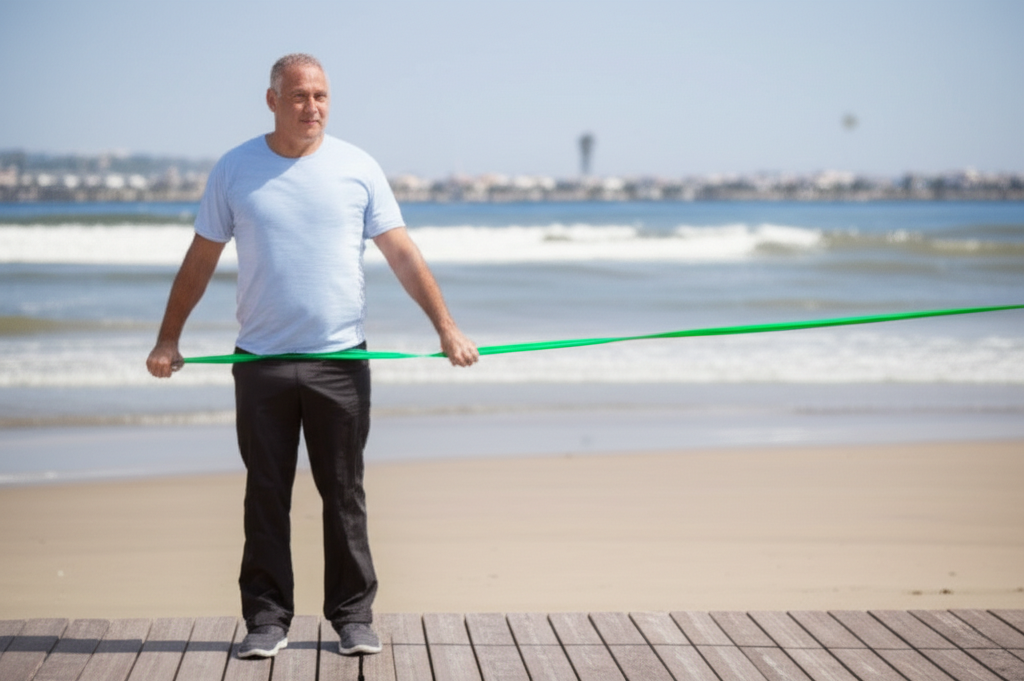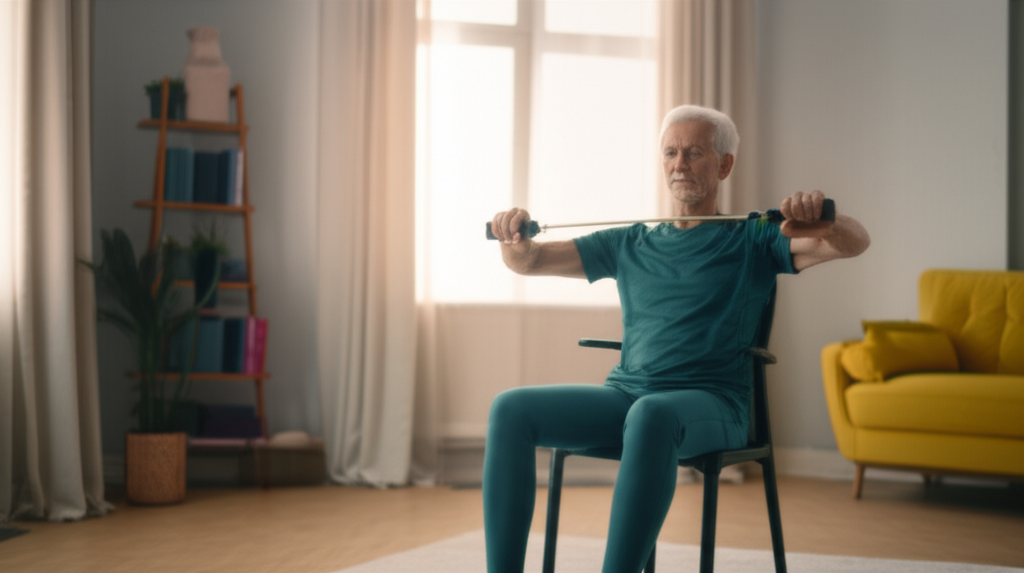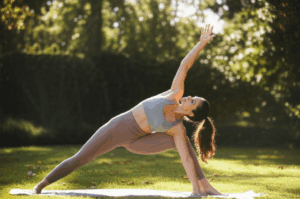As we age, maintaining physical strength, balance, and mobility becomes increasingly crucial for independence and overall quality of life. The good news is that you don’t need heavy weights or a gym membership to achieve these vital health goals. A simple, trainer-approved 15-minute resistance band routine can be a game-changer, helping individuals over 70 counteract age-related muscle loss, improve stability, and enhance daily functionality.

Why Resistance Bands Are Ideal for Seniors
Resistance bands offer a unique and highly beneficial approach to strength training for older adults. Their versatility and low-impact nature make them an excellent choice for a wide range of fitness levels.
- Gentle on Joints: Unlike traditional free weights, resistance bands provide elastic tension, which is gentle on joints and can help reduce strain, making them suitable for those with arthritis or limited mobility.
- Improved Muscle Strength and Endurance: Resistance bands effectively engage and strengthen major muscle groups, including arms, legs, and core, which are essential for maintaining independence and performing daily tasks like carrying groceries or climbing stairs.
- Enhanced Balance and Stability: Many resistance band exercises are specifically designed to strengthen muscles around the hips, knees, and ankles, as well as the core, all of which play a critical role in maintaining stability and preventing falls.
- Increased Flexibility and Range of Motion: Regular use of resistance bands can gently stretch and engage muscles, improving flexibility and increasing your range of motion over time, making everyday movements easier and more comfortable.
- Supports Bone Health: Resistance exercises help stimulate bone-building cells, contributing to maintaining bone density and reducing the risk of osteoporosis and fractures, a common concern for older adults.
- Portable and Affordable: Resistance bands are inexpensive, lightweight, and easy to store, allowing for convenient workouts at home or while traveling.

Before You Start: Essential Safety Guidelines
Prioritizing safety is paramount when beginning any new exercise program, especially for older adults.
Consult Your Healthcare Provider
Before incorporating resistance bands into your routine, it’s essential to consult with your doctor, particularly if you have existing medical conditions, injuries, or concerns. They can provide personalized recommendations and ensure the exercises are appropriate for your individual health status.
Choosing the Right Resistance Band
Resistance bands come in various levels of tension, often indicated by different colors. Seniors should start with a band that offers light resistance and gradually progress to higher levels as strength and confidence improve. Bands with handles can offer a better grip and ease of use. Always check your bands for any signs of damage, such as nicks, tears, or fraying, before each session to prevent snapping and potential injury.
Warm-Up and Cool-Down
Always begin your workout with a gentle warm-up to gradually increase heart rate and blood flow to the muscles. A cool-down routine that includes stretching after your workout can help prevent muscle soreness and promote flexibility.
Proper Form and Control
Maintain proper form and posture throughout each exercise to maximize effectiveness and minimize injury risk. Engage your core muscles for stability and move through each exercise in a slow, controlled manner, avoiding jerky movements or letting the band snap back. Remember to breathe naturally throughout each exercise, avoiding holding your breath.

Your 15-Minute Trainer-Approved Resistance Band Routine
This routine focuses on building strength, improving balance, and enhancing mobility, targeting key muscle groups in a safe and effective way. Aim to perform 10-12 repetitions for each exercise, completing 1-2 sets.
Quick Warm-Up (2 minutes)
- Band Shoulder Opening: Hold a resistance band with both hands, arms extended forward. Gently pull the band apart, drawing your shoulder blades together. Perform 5 slow breaths.
- Sit-to-Stand: From a sturdy chair, stand up and sit down slowly. Repeat 5 times to activate your hips and knees.
Band Squat (2-3 minutes)
This exercise strengthens the legs and glutes, crucial for daily activities like getting out of a chair or climbing stairs.
- How to: Stand on the middle of the resistance band with your feet hip- to shoulder-width apart. Hold the ends of the band at chest height or under your chin. Keeping your chest up, push your hips back and bend your knees as if sitting into a chair. Lower until your knees are bent to about 90 degrees or as far as comfortable. Drive through your mid-foot to stand back up.
- Trainer Tip: For easier execution, use a looser band, squat higher, or sit to a box. To increase difficulty, slow down the lowering phase to 3 seconds or add a 1-second pause at the bottom.
Band Hip Hinge (Deadlift) (2-3 minutes)
This move helps train the posterior chain (glutes and hamstrings) for safe lifting and improved posture.
- How to: Stand on the resistance band with your feet hip-width apart, holding an end in each hand. Soften your knees. Keeping your spine long and core engaged, push your hips back, allowing your torso to hinge forward while keeping the band close to your legs. Drive your hips forward to return to a standing position.
- Trainer Tip: Use a lighter band or shorter range of motion to make it easier. To increase difficulty, step wider on the band or slow the lowering phase.
Seated Row (2-3 minutes)
Excellent for strengthening the upper back, shoulders, and arms, which helps improve posture and balance.
- How to: Sit on a sturdy chair with your back straight and feet flat on the floor. Loop the resistance band around your feet or a stable anchor point in front of you. Hold one end of the band in each hand with arms extended forward. Pull the band towards your torso, squeezing your shoulder blades together and keeping your elbows close to your body. Slowly return to the starting position.
- Trainer Tip: Maintain a straight back and engaged core throughout the movement.
Standing Hip Abduction (2-3 minutes)
This exercise strengthens the muscles around the hips, crucial for maintaining balance and preventing falls.
- How to: Stand tall beside a chair or wall for support. Loop a resistance band around your ankles (or just above your knees for less resistance). Lift one leg straight out to the side, away from your body, pushing against the band’s resistance. Slowly return to the starting position. Complete a set on one leg before switching to the other.
- Trainer Tip: Keep your core engaged and avoid leaning your torso excessively. Progress to single-leg stands with band assist for a greater challenge by holding the position for a few seconds.
Band Chest Press (2-3 minutes)
This move strengthens the chest, shoulders, and triceps, aiding in everyday tasks like pushing, lifting, and transfers.
- How to: Wrap a resistance band around your mid-back, under your shoulder blades. Hold one end of the band in each hand at chest height, with elbows bent. Press the band straight forward until your arms are extended, pausing softly. Return with control to the starting position. You can perform this seated or standing with a staggered stance for stability.
- Trainer Tip: To make it easier, use a looser band or shorter range of motion. For more intensity, add a slight pause in the stretched position or slow the lowering phase.
Cool-Down/Stretching (2 minutes)
- Gentle Shoulder Rolls: Sit or stand, gently roll your shoulders backward in a circular motion, then forward.
- Leg Stretches: Perform a gentle hamstring stretch (sitting with one leg extended, reaching towards your toes) and a calf stretch (standing facing a wall, placing hands on the wall, and stepping one foot back).

Maximizing Your Results and Staying Consistent
To get the most out of your resistance band routine, remember a few key principles:
- Progressive Overload: As you get stronger, gradually increase the resistance by choosing a heavier band, performing more repetitions, or adding an extra set.
- Listen to Your Body: Pay attention to how your body feels. If you experience any pain, stop the exercise. It’s okay to modify movements or take a rest day if needed.
- Consistency is Key: Aim to perform this routine at least two days per week, as recommended for strengthening activities. Regularity is more important than intensity when building lasting strength and mobility.
Embracing a resistance band routine is a proactive step toward maintaining your physical well-being and independence. With just 15 minutes a few times a week, you can build strength, improve balance, and enhance your mobility, allowing you to continue enjoying an active and fulfilling life.







